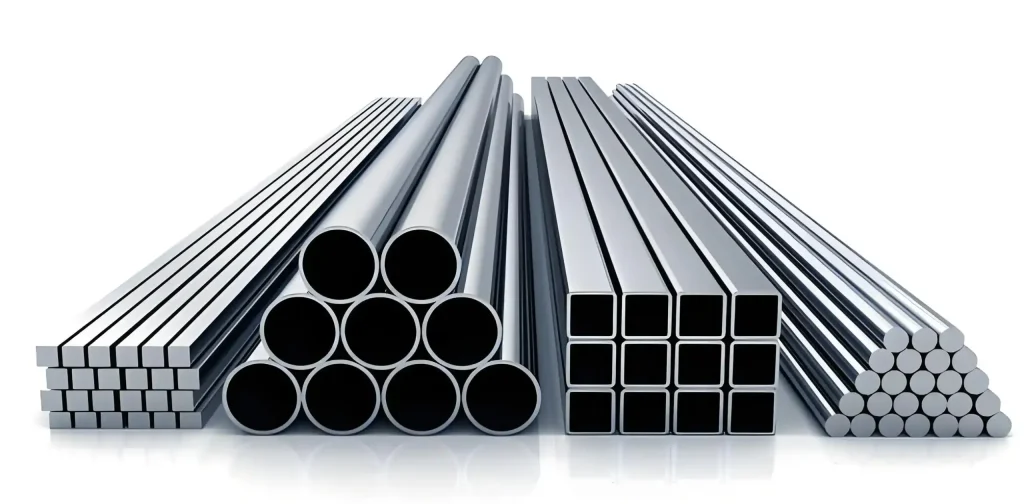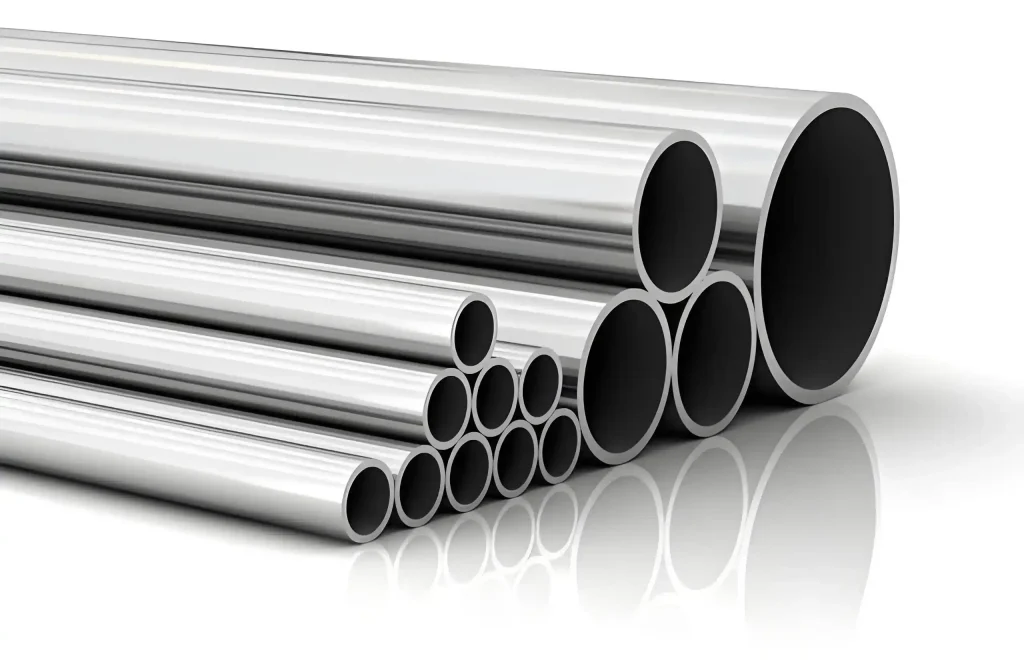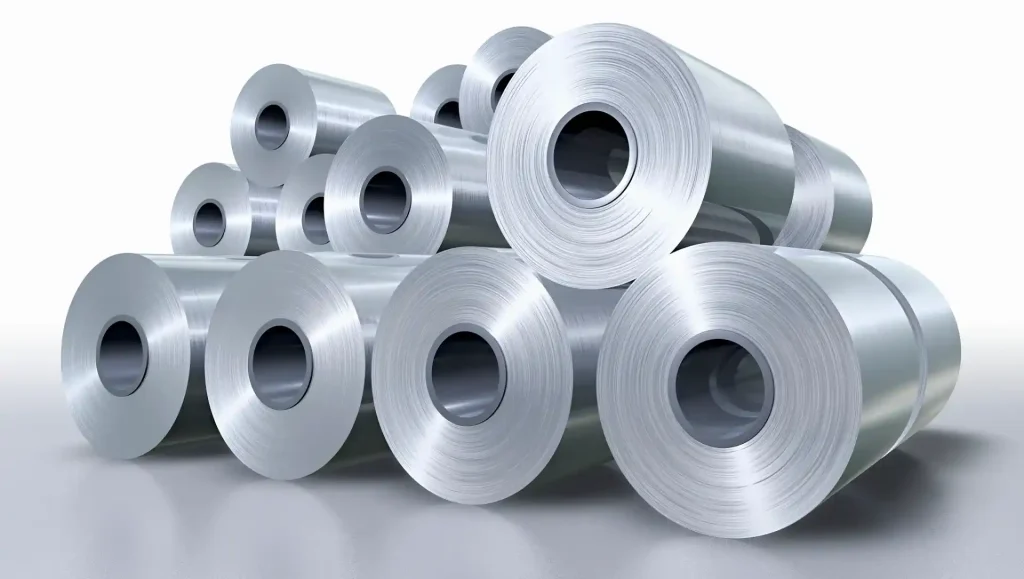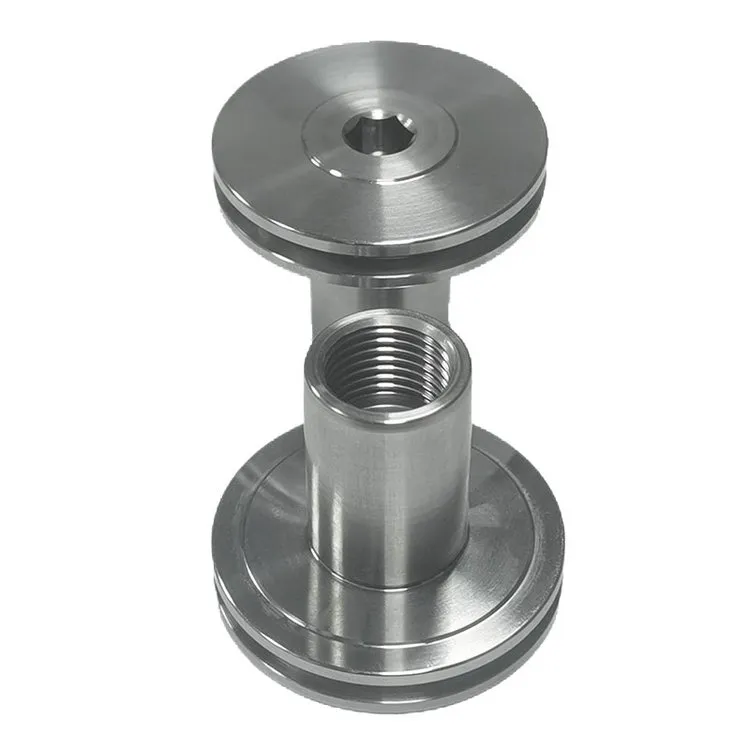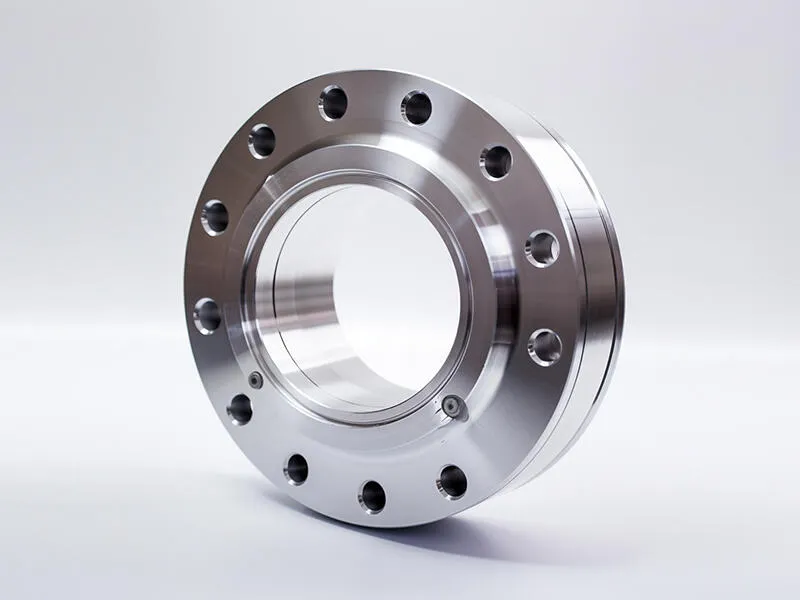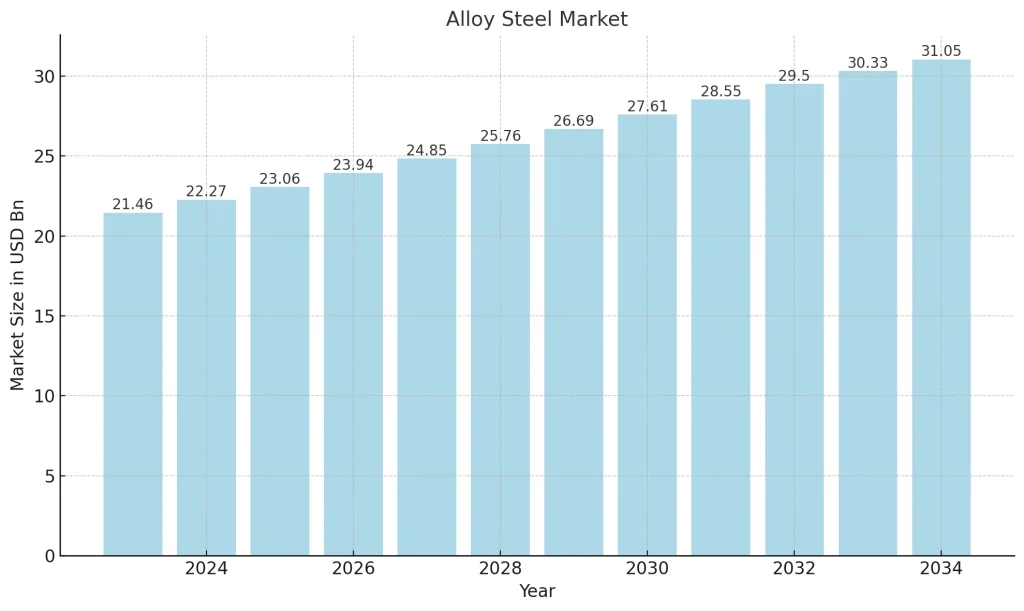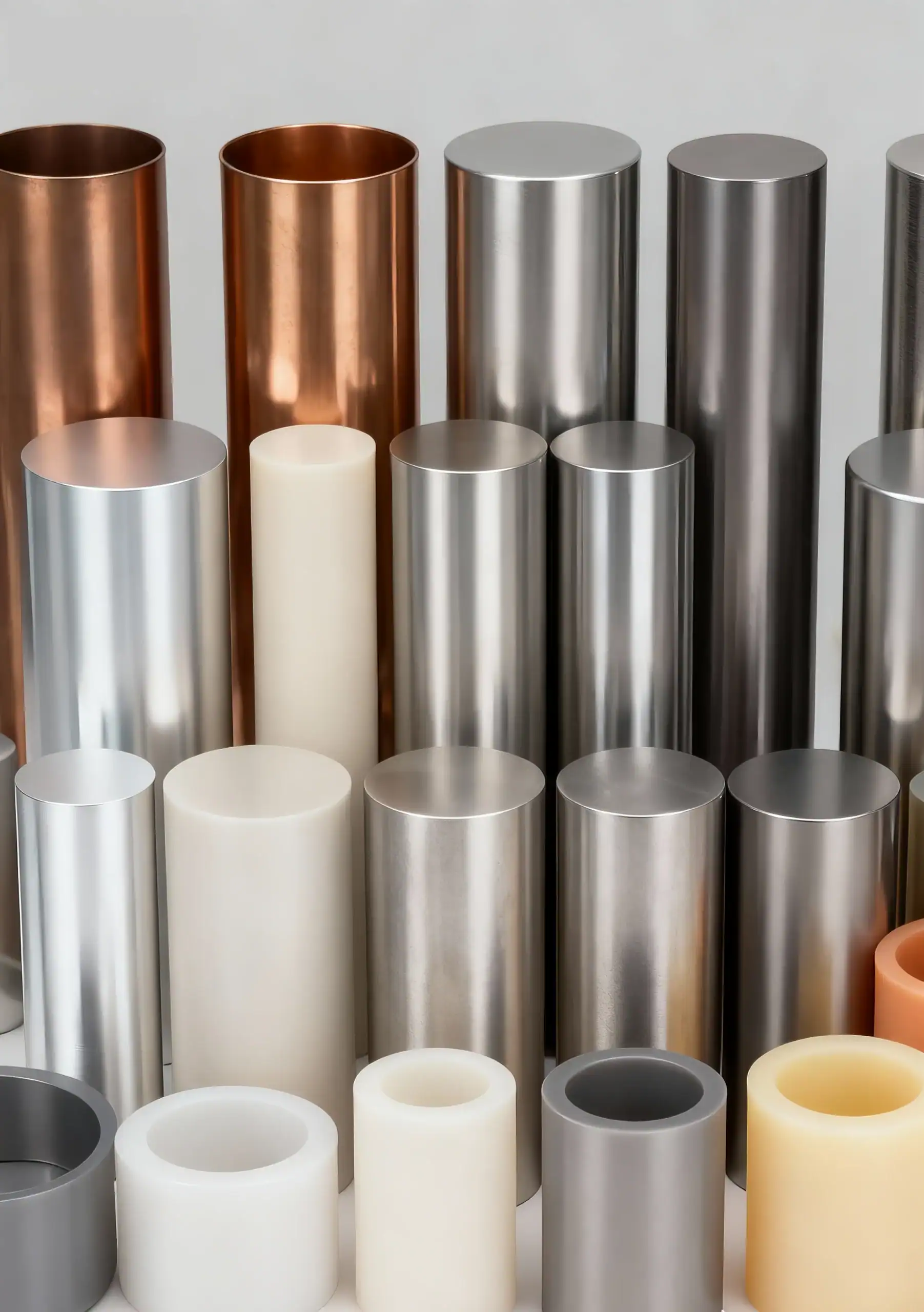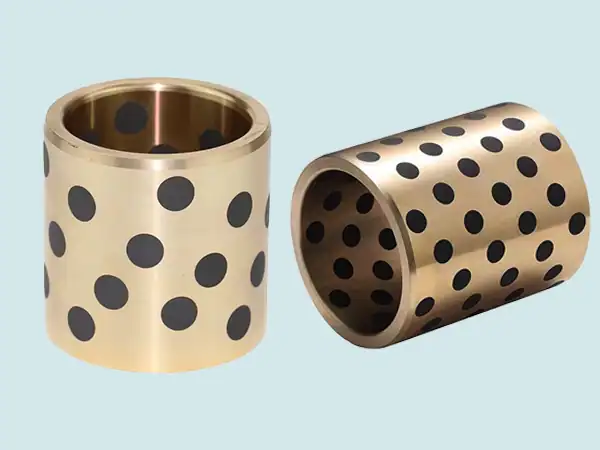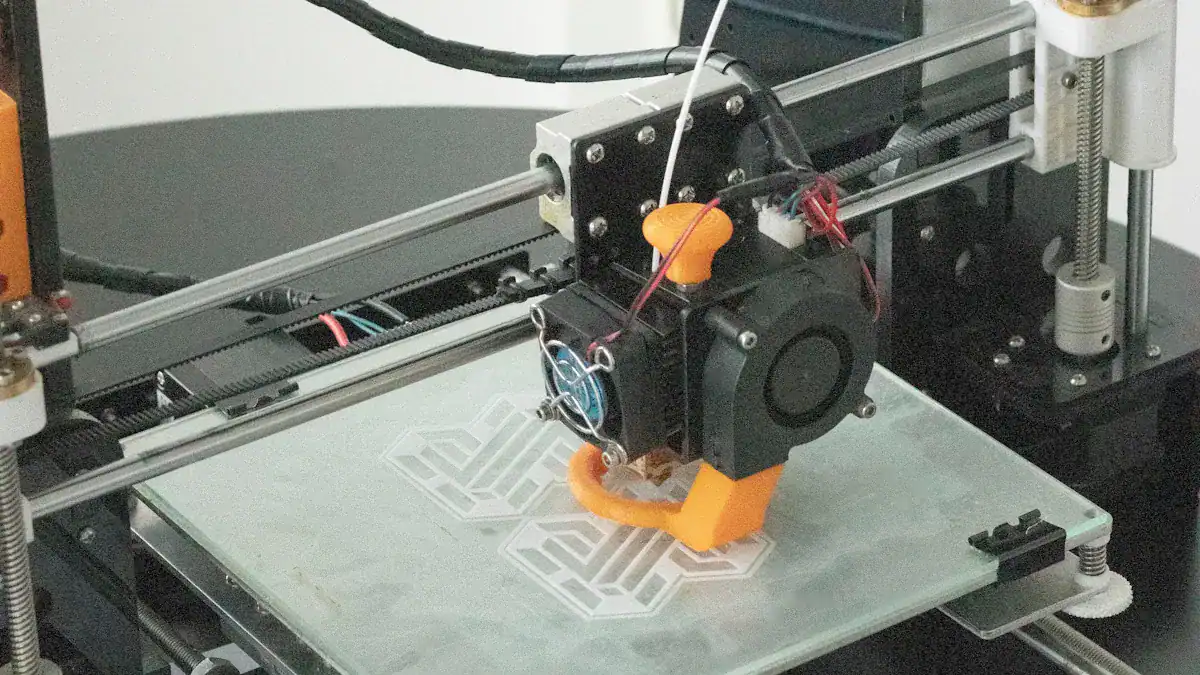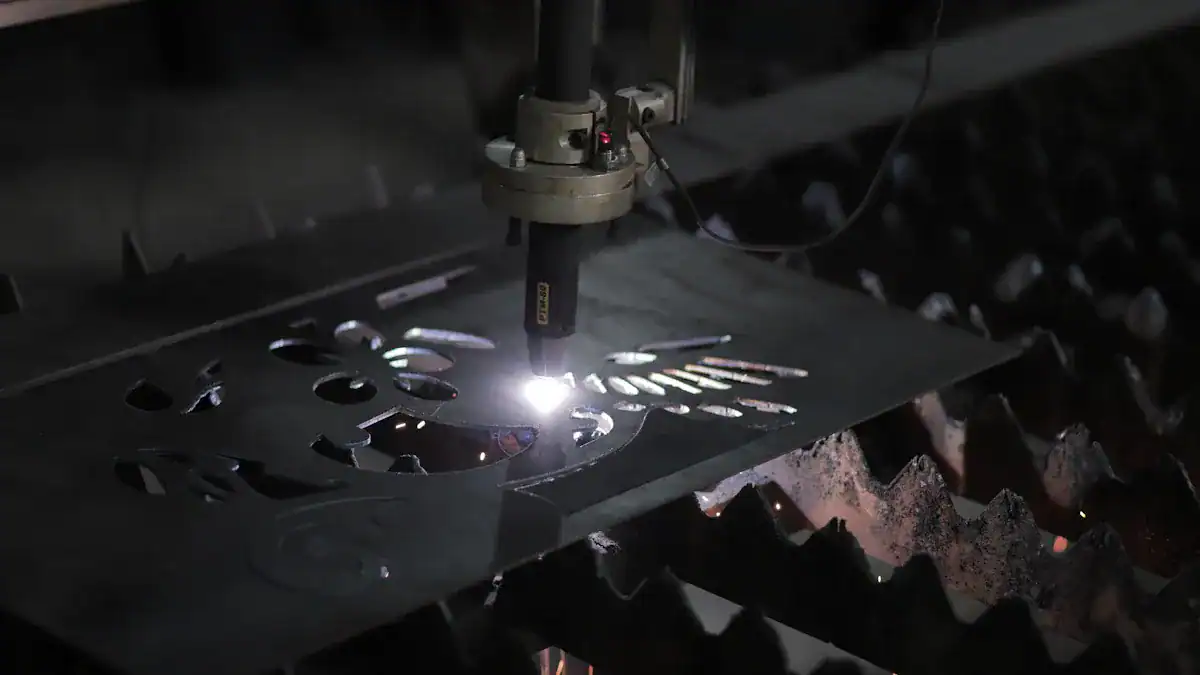Choosing the right metal for the job can be tricky. We hear terms like “alloy steel” and “stainless steel” all the time, but the real difference may not be obvious. If you’re considering the difference between alloy steel and stainless steel, this guide is designed to help. This article will explain the differences in simple terms to help you choose the best steel and stainless steel material for your project, whether it’s a high-volume production run or a single customized part. Understanding these materials is critical to the success of your project.
In short, a steel alloy is essentially a type of steel that is mixed with other elements to enhance specific properties. Stainless steel is a specific steel alloy known for its superior rust resistance.
Understanding the Basics: What is Alloy Steel?
What is alloy steel? Think of it as a formula where the main components are regular steel made of iron and carbon. Then, other elements are added to improve it in specific ways. These “extra ingredients” are called alloying elements.
These alloying elements (such as manganese, nickel, chromium, or vanadium) give the steel alloy enhanced properties, such as being stronger, harder, or more resistant to wear. Typically, these added elements make up a relatively small percentage of the material, often less than 5% for many common types of alloyed steels. This careful addition of elements allows engineers to tailor the properties of the steel for specific tasks, making it a versatile choice for many industries.
One common type we often discuss is low alloy steels. Low-alloy steel means that the steel contains a small amount of additional elements that are just enough to increase the strength of the steel or make it easier to machine without significantly increasing the cost. As a result, low alloy steels offer better properties, such as higher strength and hardenability, than basic carbon steels. Sometimes, low alloy steels also provide slightly better corrosion resistance than plain carbon steels, but usually not comparable to stainless steels. Certain types of low alloy steels have better machinability, making them ideal for processes such as CNC machining, which allows complex parts to be manufactured efficiently.
Understanding the Basics:What is Stainless Steel Material?
Now, let’s turn our attention to stainless steel material. What gives it its “stainless” quality? The key ingredient is a metal called chromium; steel must contain at least 10.5% chromium by weight to be classified as stainless steel. When chromium is present at or above this level, it reacts with oxygen to form a very thin, invisible but tough passive protective layer on the surface of the steel. This protective layer acts as a shield against rust and corrosion and even repairs itself when scratched, which is a core component of the material properties of stainless steel.
Besides iron, carbon and the all-important chromium, what other metals are stainless steel made of? Typically, nickel is another important alloying element in stainless steel materials that enhances its formability, durability, and resistance to rust. Other elements, such as molybdenum, may also be added to certain grades of stainless steel to further enhance specific properties, such as resistance to pitting.
It is important to note that there is not just one type of stainless steel material. Instead, it is a family of steels with many different grades, each tailored for specific applications. Some common categories include austenitic stainless steels (widely used for corrosion resistance and formability), ferritic stainless steels (magnetic and used for exhaust pipes and appliances), and martensitic stainless steels (known for their high hardness and suitable for knives).
Alloy Steel and Stainless Steel Composition and Classification
Alloy Steel Composition
Alloy steels are made by mixing steel with other elements. These elements, such as carbon, nickel and chromium , make the steel stronger or tougher. Each element adds something special:
- Carbon makes the steel harder and stronger.
- Nickel helps it resist rust and stay tough.
- Chromium protects it from wearing out and rusting.
The mix of elements in alloyed steels varies according to the application. Low-alloyed steels have less than 5 percent added elements, while high-alloyed steels have more. This difference affects the way the steel works in different jobs.
A study shows how these elements change the structure of steel:
|
Alloying Element Type |
Elements Included |
|
|---|---|---|
|
Austenite-Forming Elements |
Carbon (C), Nickel (Ni), Manganese (Mn) |
Keeps austenite stable, even at room temperature. |
|
Ferrite-Forming Elements |
Chromium (Cr), Silicon (Si), Molybdenum (Mo), Tungsten (W), Aluminum (Al) |
Helps form ferrite phase. |
Understanding these mixtures can help you choose the right steel for your needs, such as steel used in buildings, cars or airplanes.
Stainless Steel Composition
Stainless steel is a high-alloy steel with a chromium content of at least 10.5%. This chromium forms a layer that prevents rusting. It can be further improved by adding other elements such as nickel and molybdenum.
Below is a brief description of common stainless steel types:
|
Stainless Steel Grade |
Microstructure |
Composition Details |
|---|---|---|
|
Austenitic |
Has iron, chromium, nickel |
|
|
AISI 316L |
Austenitic |
Has iron, chromium, nickel, molybdenum |
|
AISI 430 |
Ferritic |
Has iron, chromium |
|
AISI 2205 |
Duplex |
Has iron, chromium, nickel, molybdenum |
The structure of stainless steel depends on its mixture. austenitic types such as AISI 304 and 316L do not attract magnets and are rust-resistant, so they are used for kitchen tools and medical equipment. Ferritic types like AISI 430 attract magnets and cost less, which makes it ideal for automotive parts. Duplex types are strong and rust-resistant, combining the best of both worlds.
Types of Alloy Steel
Alloy steels are categorized into two groups based primarily on the content of added elements:
- Low Alloy Steel: Containing less than 5% alloying elements, it has high strength and good toughness and is commonly used in construction, piping and automotive parts.
- High Alloy Steel: Containing more than 5% alloying elements, it has excellent resistance to wear and corrosion and is used in tools, molds and high temperature components.
Modern smelting techniques, such as electric arc furnaces, have simplified the custom production of specialty alloy steels, allowing precise compositional adjustments to optimize the performance and durability of steel for specific applications. For example, low-alloyed steels are widely used in the construction industry for their strength and cost-effectiveness, while high-alloyed steels are used in extreme environments such as aerospace and power plants.
Stainless Steel
There are many types of stainless steel, depending on their composition, structure and properties:
- Austenitic Stainless Steel (e.g. 304, 316L): The most common, rich in chromium and nickel, highly corrosion resistant and non-magnetic. Wide range of applications, including construction, automotive, aerospace and food industries.
- Ferritic stainless steel (e.g. 430, 409): higher chromium content, lower nickel content, magnetic, medium corrosion resistance, lower cost. Commonly used in automotive exhaust systems, kitchen appliances.
- Duplex Stainless Steel (Duplex): combines austenitic and ferrite properties, balanced chromium, nickel and molybdenum content, high strength, resistance to stress corrosion. Suitable for chemical plants, oil and gas industry.
- Martensitic stainless steels (e.g. 410, 420): high hardness, high strength, good wear resistance, but relatively low corrosion resistance. Used for cutting tools, medical equipment and high-strength components.
Alloy Steel vs Stainless Steel: Comparison of Properties
Strength Comparison
Alloy steel and stainless steel have different strengths. Alloy steel contains more carbon and added metals like nickel and manganese, so it can be very strong. This also makes it great for heavy work such as building structures and making cars. Stainless steel uses chromium to maintain toughness and resist environmental damage.
|
Material Type |
Manufacturing Method |
Yield Strength (MPa) |
Tensile Strength (MPa) |
Elongation at Break (%) |
|---|---|---|---|---|
| 316L | SLM |
Higher than FFF |
561 | 59 |
| 316L |
Wrought |
621 |
N/A |
59 |
|
17-4 PH |
Metal FFF |
1068 |
N/A |
61 |
|
17-4 PH |
SLM |
Comparable to MIM |
N/A |
N/A |
This table shows the effect of manufacturing methods on stainless steel. For example, 316L stainless steel made using selective laser melting (SLM) technology is stronger than stainless steel made using fused metal filament fabrication (FFF) technology. In addition, 17-4 PH stainless steel made with FFF metal is also very strong.
If your project requires a material that can withstand heavy loads, alloy steel is better. However, where rust resistance is as important as strength, stainless steel works best.
Hardness and Ductility
Hardness refers to the toughness of a material, while ductility refers to the degree to which it can be bent without breaking. Alloy steel is harder because of its carbon and other elements. This is what makes it suitable for tools and machines that need to resist wear and tear.
Stainless steel isn’t as hard, but is more flexible. It can be stretched and bent without breaking, which is useful for items such as kitchen tools and medical equipment. grades such as 304 and 316L are particularly flexible, so they can be molded into detailed designs without cracking.
Fatigue Resistance
Fatigue resistance is the ability of a material to handle repeated stresses. Alloy steels are better in this regard because of their strong structure. With the addition of metals such as molybdenum and vanadium, alloy steels are even tougher. This is why alloy steels are used in parts that face constant stress, such as gears and shafts.
Stainless steels are less able to handle stress, but excel where rust and stress are both present. Duplex stainless steels blend the two structures and resist fatigue better than other stainless steels.
For example, low alloy steel is used in bridges and cranes because it handles repetitive loads well. Duplex stainless steels are used in marine applications where both rust and stress are a problem.
Comparison of Impact Resistance
- Alloy Steel.
- Performance: Alloy steels generally have excellent impact resistance. The addition of carbon, nickel, manganese, molybdenum or vanadium can significantly increase their toughness and ability to absorb impact energy, preventing fracture.
- Scenario: Ideal for machines, bridges or tools subjected to impact loads, such as crane components.
- Stainless Steel.
- Performance: The impact resistance of stainless steel varies by type. Austenitic stainless steels (e.g. 304, 316L) exhibit better impact resistance than ferritic or martensitic stainless steels due to their flexible structure.
- Scenario: Suitable for applications where both impact and corrosion resistance are required, e.g. ship propellers, which can resist corrosion while resisting the impact of water and debris.
If extreme impact resistance is your primary concern, alloy steels are superior because their composition can be adjusted to maximize toughness. If the application also requires good corrosion resistance with moderate impact, specific types of stainless steels, especially austenitic, are a more suitable choice.
Corrosion Resistance of Alloy Steel and Stainless Steel
Corrosion Behavior of Alloy Steel
Alloy steel protects against rust, but it depends on its composition. The addition of chromium, nickel and molybdenum helps prevent rust and chemical corrosion. Low-alloyed steels with less than 5% added elements do not perform well in harsh conditions. High-alloyed steels with more added elements cope better with corrosion.
If alloy steel is exposed to moisture or chemicals, it may rust unless treated. Coatings such as paint or galvanizing can extend its life. For example, the meta-alloy Meta is a low-alloyed steel that is used in construction projects because it is strong and resistant to rust.
Corrosion Behavior of Stainless Steel
Stainless steel is highly resistant to rust. Its chromium forms a thin invisible layer that stops rusting and repairs itself after scratching. Austenitic stainless steels such as AISI 316L and 304L work well in wet or chemical-rich areas.
Tests on AISI 316L and 304L have shown that they are virtually rust-free, even with temperature changes. Special tools have found that molybdenum and chromium make them more resistant to rust. The chromium layer protects these steels from corrosion.
Heat Treatment and Fabrication
Weldability Comparison
Alloy Steel and Stainless Steel are welded differently due to their different material compositions. Alloy steel, especially low alloy steel, is easier to weld. This is because it has less carbon content. It is commonly used in construction and automobile manufacturing, and welding is common in these areas. However, adding metals such as chromium or nickel can make welding more difficult.
Stainless steel requires more care when welding. Its high chromium content prevents rusting, but can lead to cracks if not handled properly. Austenitic stainless steels such as 304 and 316L are the easiest to weld. Ferritic and martensitic types are harder to weld because they are more brittle.
Machinability
Machinability is the ease of cutting or shaping the material. Alloy steel is easier to machine than stainless steel materials. It is softer and more flexible for precision machining.
Stainless steel is more difficult to machine because it is stronger and less prone to rust. grades such as 304 and 316L wear out tools more quickly. However, new machining methods have made stainless steel better to work with.
Here’s a workability comparison:
|
Metric |
Alloy Steel (Range) |
Stainless Steel (Range) |
|---|---|---|
|
758-1882 MPa |
515-827 MPa |
|
|
Ductility |
Higher |
Lower |
|
Fatigue Strength |
Higher |
Lower |
Formability
Formability is the degree to which a material will not break while being molded. Alloy steel is better at this because it is more flexible. It is ideal for making detailed parts such as automotive components. Low-alloy steel is especially good because it is strong and easy to mold.
Stainless steel materials are strong but less flexible.304 Austenitic steels, such as 304, are easier to form than ferritic or martensitic steels. However, the strength of stainless steel makes it more difficult to detail.
- Main Formability Differences:
- Alloy steels are easy to bend and stretch and are good for detailing.
- Stainless steels are more difficult to mold, especially ferritic and martensitic types.
By understanding the differences in weldability, machinability and formability, you can choose the right Alloy Steel and Stainless Steel material. Each type has its own advantages, so consider your project needs before making a decision.
Heat Treatment Techniques
Heat treatment can change the properties of metals such as steel alloys and stainless steel materials. Metals can be made harder, stronger, or more bendable through specific heating and cooling methods. This process helps to make the material meet the needs of the project.
Common Heat Treatment Methods
- Annealing
Annealing is the softening of metal by heating and slow cooling. This helps low-alloy steels become easier to bend and reduces internal stresses. For example, annealed meta-alloy Meta is easier to cut and shape. - Quenching
Quenching usually involves heating metal in water or oil and cooling it quickly. This makes the metal harder and stronger, making it ideal for tools and parts that wear out. However, quenching can make stainless steel materials brittle unless they are tempered after quenching. - Tempering
Tempering solves the problem of brittleness caused by quenching. The metal is heated to a lower temperature and then cooled slowly. This balances hardness and toughness and is good for steels and stainless steels used in tools or machines. - Solid solution treatment
This method is suitable for the properties of austenitic stainless steel materials. Heating removes unwanted particles and rapid cooling locks in the structure. This improves rust resistance and strength, especially in steels such as 316L. - Surface Hardening
Surface hardening creates a hard outer layer on a steel alloy while keeping the interior soft. The metal is heated in a carbon-rich region. It is ideal for gears and shafts that need a hard surface to withstand wear.
How Heat Treatment Affects Steel Types
|
Steel Type |
Heat Treatment Effect |
Best Use Cases |
|---|---|---|
|
Low Alloy Steel |
Becomes stronger and easier to machine |
Buildings, car parts |
|
Austenitic Stainless |
Gains rust resistance and toughness |
Food tools, medical devices |
|
Martensitic Stainless |
Gets harder and resists wear |
Knives, cutting tools |
Applications
Uses of Alloy Steel
Alloy steel is strong and has a long service life. It is used in industries that require hard materials. You’ll see it in construction, automotive and energy projects.
- Construction: Alloy steel is used in bridges, pipelines and buildings. It keeps structures safe and strong for years.
- Automotive: Automakers use alloy steel to make gears and engine parts. It helps cars withstand heavy loads and travel quickly.
- Energy: Power plants use alloy steel to make turbines and boilers. It works well at high temperatures and pressures.
Studies show that the demand for alloy steel is growing. Plate and sheet are expected to grow at an annual rate of 3.68% through 2034. Tubes will grow by 3.59%.
|
Segment Type |
Growth Rate (2023-2034) |
|---|---|
|
Plates and Sheets |
3.68% |
|
Tubes and Pipes |
3.59% |
|
Forgings and Castings |
3.43% |
Uses of Stainless Steel
Stainless steel prevents rust and can be used in many places. It can be used for household items and large machines.
- Construction: Stainless steel can be used for railings and roofing. It stays strong in wet or salty areas.
- Automotive: Stainless steel is used in car exhausts and gas tanks. By 2025, each car could use 25 kg of stainless steel.
- Renewable Energy: Stainless steel is used in wind turbines and solar panels. It copes well with harsh weather.
- Food Processing: Stainless steel is safe for food tools and storage. Stainless steel accounts for 60% of the food equipment market, which will reach $87.6 billion by 2027.
|
Application Area |
Facts |
|---|---|
|
Construction |
Global construction output may grow 85% to $15.5 trillion by 2030. |
|
Automotive |
Stainless steel use in cars grows 5% yearly; may reach 25 kg per car by 2025. |
|
Renewable Energy |
Renewable energy capacity grew 9.6% in 2023, reaching 3,589 GW globally. |
|
Food Processing |
Food equipment market may hit $87.6 billion by 2027, with stainless steel making up 60%. |
Cost and Environmental Impact
Cost Comparison
Alloy steel costs less than stainless steel. It uses fewer expensive elements such as chromium and nickel. Low alloy steels contain less than 5% of additional elements and cost even less. This makes it ideal for large projects such as bridges or pipelines.
Stainless steel contains at least 10.5% chromium and is therefore more expensive. Grades such as 316L, which contain molybdenum, are more expensive because they provide better rust protection. If your project requires the material to be used in wet or harsh environments, the high price of stainless steel may be worth it.
|
Material Type |
Average Cost (per ton) |
Why It Costs More |
|---|---|---|
|
Low Alloy Steel |
$700-$1,000 |
Fewer expensive elements |
|
Stainless Steel |
$1,500-$2,500 |
Chromium, nickel, and molybdenum |
Lifecycle Costs
Alloy steel is cheaper at first, but can cost more later. Without a coating, they can rust or wear out and need to be repaired or replaced. For example, low-alloy steel works well in dry areas, but needs protection in wet or salty areas.
Stainless steel has a higher upfront cost, but saves money over time. Its rust resistance reduces maintenance costs. grades such as 304 and 316L last longer and are ideal for long-term uses such as food equipment or marine structures.
Sustainability and Recycling
Both alloy steel and stainless steel are recyclable, making them eco-friendly. Stainless steel lasts longer and needs less upkeep, saving resources. Its rust resistance means fewer repairs or replacements.
Over 80% of stainless steel is recycled worldwide, cutting the need for raw materials like chromium and nickel. Alloy steel is also recyclable but doesn’t last as long, so it’s recycled more often.
Advantages and Disadvantages
Alloy Steel Pros and Cons
Alloy steels are known for their high strength and durability and can be customized for different applications, but there are some drawbacks.
Advantages
- High Strength and Toughness: Very strong (up to 960 MPa) for demanding applications such as construction and automotive manufacturing.
- Good Thermal Conductivity: Good thermal conductivity (45 W/(mK)) for power plants and machinery.
- Customizable: Carbon, nickel and other elements can be adjusted to meet specific performance requirements.
- Cost Effective (specifically low alloy steels): Low alloy steels are less expensive than stainless steels and are suitable for large projects such as bridges and pipelines.
Disadvantages
- Risk of corrosion: Rusts easily in humid or salty environments without proper coating protection.
- Risk of hydrogen embrittlement: In certain environments, such as those containing hydrogen sulfide, hydrogen damage may occur causing the material to become brittle.
- Regular maintenance: Surface treatments such as painting, galvanizing, etc. are often required to prevent corrosion and wear and tear, increasing long-term costs.
Stainless Steel Pros and Cons
Stainless steel is known for its excellent corrosion resistance and bright appearance, and is particularly suited to wet or chemical environments, but there are some drawbacks.
Advantages
- Superior Rust Resistance: The core benefit is a minimum 10.5% chromium content, which creates a protective layer against rust and corrosion, making it ideal for wet or chemical environments.
- Low Maintenance: Due to its excellent resistance to rust and corrosion, it requires less routine maintenance and is more economical in the long run.
- Aesthetics: Clean and modern surface, widely used for railings, kitchen utensils and other products where appearance is important.
- High Strength of Specific Types (e.g. Duplex Stainless Steel): Specialty types such as duplex stainless steel combine high strength with excellent corrosion resistance, making them suitable for use in harsh environments such as ships and chemical plants.
Disadvantages
- Higher Cost: Containing precious metals such as chromium and nickel, it is usually more expensive than alloy steels, with certain grades (e.g. 316L with molybdenum) costing even more.
- Relatively Poor Thermal Conductivity: Its thermal conductivity (about 15 W/(mK)) is lower than that of many other metals, making it unsuitable for use as a primary thermal conductive material.
- Difficult to Machine: Often hard and ductile, they are more difficult to cut and form, which can lead to faster tool wear and higher machining costs.
Considerations For Choosing Steel
When choosing between alloy steel and stainless steel, the following key aspects need to be evaluated in a comprehensive manner:
Functional Requirements
The decision needs to be based first and foremost on the actual working conditions and performance requirements. Alloy Steel and Stainless Steel typically offer higher strength and better machinability, making them suitable for structural load-bearing and complex designs, while Stainless Steel, with its excellent corrosion resistance, is ideal for wet, chemically corrosive environments as well as hygienically demanding applications.
Budget Constraints
Cost is a major constraint in projects. Generally speaking, Alloy Steel and Stainless Steel have relatively low initial purchase costs and are more suitable for projects with limited budgets or high volumes; while Stainless Steel has a higher initial investment, but its excellent durability and very low maintenance requirements in demanding environments tend to bring better long-term overall economic benefits.
Aesthetic Preference
In terms of appearance, stainless steel is popular in architecture, interior design, and in areas where product value is important, as it often has a highly reflective, polished surface that presents a modern, sleek texture. Alloy steels, on the other hand, can be coated, painted, and other surface treatments to achieve a variety of industrial styles or customized looks.
Maintenance And Life
From a long-term perspective, stainless steel is often superior in terms of maintenance and longevity. It requires little or no maintenance and, due to the self-repairing properties of its surface layer, will last and look good in a wide range of environments. In contrast, alloy steels may require regular corrosion treatment and maintenance in wet or corrosive environments to ensure performance and longevity.
Conclusion
In industrial manufacturing, construction or demanding environments, choosing the right metal material can make or break a project. Alloy Steel and Stainless Steel are preferred for high volume manufacturing and structural applications due to their outstanding strength and cost effectiveness, while Stainless Steel performs better in wet, chemical or food hygiene applications due to its excellent corrosion resistance and low maintenance costs. Both are different, and the key is matching your specific application needs.
At Future Parts, we don’t just understand materials, we understand how to provide the optimal solution for our customers. Whether you’re looking for high-strength structural components or long-lasting stainless steel, our team of professionals and state-of-the-art manufacturing processes will always customize the right choice for you. When you choose Future Parts, you’re choosing a future of quality, performance and efficiency.
